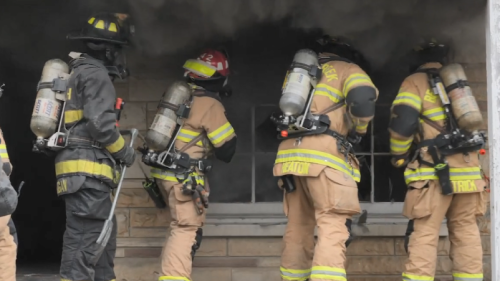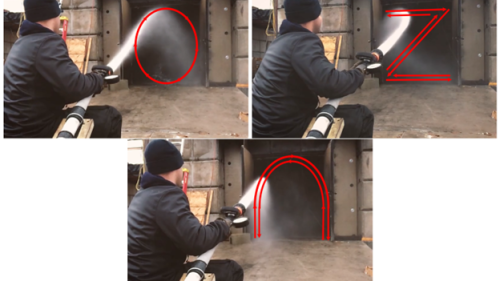When it comes to officer-level promotions, there is no honeymoon period. You need to immediately step up your knowledge base in all aspects of your new position. You better know it all or at least know how to obtain the information you need. The men and women under your command expect you to know it all. Everything is your responsibility now. Are you ready?
There is a lot to learn as a new officer, so here, we’re going to cover just one slice – the company officer’s responsibilities related to vertical ventilation. That includes what to do before ever getting on the roof, what to do while on the roof and what to do after ventilation is complete.
Company officer ventilation duties
First things first: You do not get to cut holes anymore! If you’re using your rank so that you get to cut all the holes, you are doing it wrong and you are being a poor leader. Sorry if that stings, but it’s the truth. Remember, many would consider your new role to be more important than the task itself. Does that lessen the sting?
As the company officer, your role on the roof is that of an observer and safety officer. Your job is to maintain situational awareness, observe the firefighters’ actions and make corrections as necessary – nothing more, assuming you trained your crew thoroughly. You are the first one on the roof and the last one off. Always keep your crew in front of you (except to sound the roof) to maintain visual accountability and situational awareness.
Now let’s drill down to the specifics of officer responsibilities during ventilation operations.
Follow the science: Read all the UL Fire Safety Research Institute (FSRI) studies regarding vertical ventilation. Their research confirms what we know: Vertical ventilation works!
Be mindful, however, that there is some debate as to the definition of coordinated vertical ventilation. From my experience and study, we can vent before water on the or while applying water on the fire and after water on the fire – basically, anytime you want. However, the key reason we ventilate, and the way that we make it safer for our attack team, is to perform vertical ventilation before or very shortly after the crew actually enters a hostile environment. We should ventilate first. Wait to confirm that the ventilation is having the effect we want and then send in the attack team. We want to see that the change in our flow path is up and out; we do NOT want to send them into a charged situation primed for a backdraft.
Also, keep in mind that heat and pressure help create the flow path. Applying water before vertical ventilation ignores that science. Plus, it runs counter to the safety benefits afforded for the attack team making their way to the seat of the fire, and will only slow the ventilation process once the heat and pressure are reduced by the application of water, almost making it pointless to ventilate at all at that point.
Understand building construction: Before we go deeper into strategies and tactics, it’s important to address building construction, not what you can read in books but rather the buildings in your response area. Stay attuned to what’s going on (and up!) in your territory, not only the methods of construction but also the materials used in that construction. Get out of the apparatus and get an up-close look at the newest structures. As the company officer, you set the training tone, and it’s important that you work building construction into the rotation.
[Read more about the officer’s role in building construction as it pertains to vertical ventilation.]
Manage member expectations: You should verbally inform your members of your expectations, and explain your standards so that they understand why your standards are high. Regarding vertical ventilation, explain to your members in detail how they will ONLY walk where they have already walked and will only work in the area sounded and designated by the company officer. This message must be driven home to your firefighters. Reinforce this with hands-on training.
Train your team: You are responsible for all aspects of team training! Have you attended a fire academy training recently? They are learning the minimal standards. Many academies around the nation have adopted a simple no-fail policy, I presume because fails hurt their image and government funding. The academies and state requirements have been watered down to the point that it is dangerous to put cadets on the streets. Many large municipal departments have also adopted the same approach. If this sounds like your department, remember, it is up to YOU as the company officer, to train your crew to the level you expect of them. Do you get it yet? Your role is critical to fireground success.
I am not an advocate of micromanagement; however, for operational effectiveness and situational awareness during training, you as the company officer should explain how you want the hole cut and train on that method. This ensures everyone is on the same page when you actually go to perform vertical ventilation. You can watch from a distance to see whether things are going according to plan and determine when to make corrections or take action if necessary. It is OK to train on other methods, for example, in case the roof is not conducive to your operational plan, but having a go-to method is critical for efficiency.
Train your members to understand every aspect of vertical ventilation. Why we do it, how we do it, when we do it and why we might not do it, plus what to expect when we do it right and what to expect when we do it wrong.
Your crew should be trained to the point that communications is as simple as pointing or some other form of hand signal, as the saw or saws will be running and everyone will be wearing their SCBA, making verbal communications difficult.
Train your crew to be ambidextrous with the use of their saws. The ventilation crew will often be required to cut from their weak side. Training for this will reduce the awkwardness and speed the operation during those situations.
Train your crew to make cuts with the saw from the confinement of a roof ladder and the tip of the aerial ladder. When these methods are called for, you can observe who has trained for it and who hasn’t. It often looks awkward, difficult and could be very time-consuming. If you train, your members will be better prepared and understand what to do at the time and be more fluid.
Finally, training our crews to recognize warning signs is how we avoid getting into bad situations in the first place. For example, train your members to know what to do if they suddenly feel the decking giving way or becoming spongy. The decking in residential structures will be the first construction feature to weaken or fail. Train them to fall across rafters, reach out for additional rafter, and spread their weight across multiple rafters, as the decking is typically what fails first. This knowledge nugget could mean the difference between falling through the roof or climbing down the ladder like you came up.
Bottom line: Training is the only thing that makes our job on the roof safer and our members more efficient, so train regularly.
Perform a size-up: The size-up for vertical ventilation is a little more challenging than the typical size-up for attack. First, you have to look UP. Also, you may not have time to do a complete 360 as you are looking for the quickest way to the roof. You will typically be doing your roof size-up and ongoing size-up under hostile conditions.
When doing a size-up for vertical ventilation, we are first looking for where the most smoke is coming from, then where the fastest, most turbulent smoke is coming from. That will be our target area once on the roof. Turbulent smoke means hotter smoke and smoke that is under pressure, hence, closer to the fire.
When on the roof, you will continue to size up the structure throughout the duration of the operation. This also falls directly in line with your job of maintaining situational awareness.
In doing the size-up, we are looking for our target area. We use our tools to sound and we can use our thermal imager to look for heat. Outward signs of our target area include looking for smoke pushing through shingles, tar running down the top of shingles, shingles starting to burn (step back a rafter or two) and spots where the decking might be sagging a bit between rafters.
Sound the roof: You should have sized up the fire from the ground, giving you a good idea where the seat of the fire is and start working their way in that direction from a safe starting point.
Sounding the roof is your most important job on the roof. Do not take this responsibility lightly!
The first step in proper sounding is to choose the right tool – a tool with reach – for sounding the roof. Not your boot. Not your axe. It’s best to use a roof-hook or trash-hook that’s 6-8 feet in length. A longer tool affords an extra measure of safety, as the weak spot will be revealed sooner and from a safer distance.
Strike with force, not a passive bounce. I prefer to try and drive my tool through the roof decking 4-6 feet ahead of me. Once my tool penetrates the roof decking, I move back a step and sound out a work area for the members performing ventilation using the same method. Then it’s time to give the order to begin cutting. Step back, keeping all members in front of you, and watch your members and listen to the radio reports. Watch the firefighters cut the holes, clean out the hole, and then return to the ladder to exit the roof.
If you did your job explaining expectations and training your members on how to cut the hole efficiently and effectively, then everything should go as planned. However, too often, we see things that don’t go as planned and we experience a close call or an injured firefighter. Guess what? That is the officer’s fault 100% of the time. There is no denying that. No getting out of that. No excuses.
Ensure member safety: Beyond sounding the roof, there are other ways you can provide a safe environment on the roof. For example, I prefer to move below the area where the firefighters are working. I drive my roof hook into the decking behind them and move to the side so that I have a clear path to observe their actions. If a member was to fall backward or begin to slip, I would drop to my knees, and my roof hook is there to stop them from proceeding any further.
Many officers mistakenly believe that holding onto a firefighter who is performing the ventilation will somehow protect the firefighter from falling into a weakened roof. Sorry, but no. You are doubling the load in the weakened area, thereby doubling the odds of falling through. You are also hindering the member’s natural movements. I have seen many times where the company officer was crowding the firefighter cutting the hole, essentially getting in the way of a running saw.
Lastly, roof ladders, while cumbersome to the operation, can be critical to firefighter safety. Steep pitched roofs and roofs that are in disrepair will drive the use of a roof ladder, maybe two roof ladders if your crew is proficient. Do not forego vertical ventilation on a bad roof if you are still sending an attack crew under that very same roof. Use a roof ladder and work from that roof ladder. I have yet to discover a documented LODD of a firefighter falling through the roof while working from a roof ladder. The roof ladder is a very effective tool in distributing our weight.
Final thoughts
Officers, it’s simple. It’s your responsibility. All yours. Everything. Every time. Regardless of the circumstances. Take it seriously and personally. Train your crew and continue to learn your job. If you’re not willing to accept every mistake your company makes as your own, you’re not ready for the job as a company officer.
Stay safe on the roof by getting out and training your crew to a level of complete understanding. The only real way to keep your members safe is to train them thoroughly and observe them while they perform the way you trained them.









